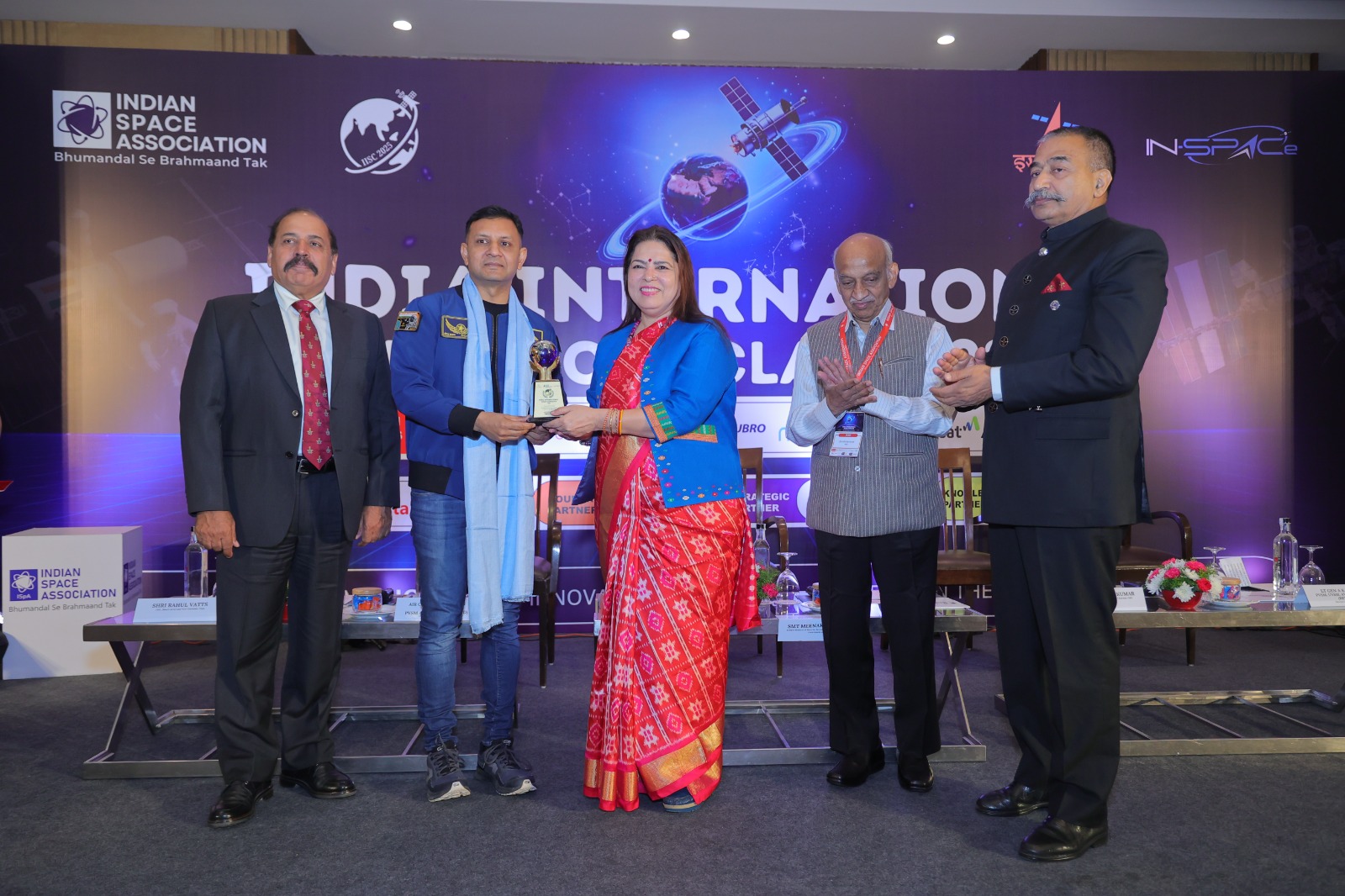The India International Space Conclave (IISC) 2025 wrapped up on November 19 with what felt like a clear and rather emphatic message. Many of the speakers, from astronaut designates to senior ISRO experts, urged India to step into a larger global role in space exploration, policy shaping, and long-term sustainability. The two-day event, hosted by the Indian Space Association (ISpA), brought together more than 1,000 participants, and there was a noticeable consensus that India is entering a phase where it not only contributes but also helps guide the direction of global space activity. One of the most significant developments was the signing of a Letter of Intent (LoI) between the European Space Agency (ESA) and ISpA, aimed at deepening cooperation and knowledge-sharing between Europe and India’s fast-growing space sector.
Key Takeaways from IISC 2025
Global South Representation: A recurring theme, spoken with a sense of urgency at times, was that India has a responsibility to ensure that the Global South has a meaningful voice in the formation of future space governance frameworks. Several leaders noted that if India does not move quickly, decisions that shape the next few decades of space activity may be dominated by already powerful spacefaring nations.
Competence and Collaboration: Former ISRO Chairman AS Kiran Kumar reminded the audience that real technological competence remains the basis for both recognition and partnership. He hinted, perhaps cautiously, that global collaboration becomes far more equitable when a country demonstrates its own strengths, which also reduces the risk of any single nation exerting outsized control over space.
ESA-ISpA Partnership: The newly signed LoI between ESA and ISpA is expected to open doors for joint research, commercial initiatives, and capacity-building programs. This felt like more than a symbolic gesture; it signals a growing strategic link between European agencies and India’s private and public space players.
Beyond Human Spaceflight Gp. Capt. Angad Pratap, one of the astronaut designates, spoke about looking past the headline-grabbing idea of sending humans to space. He emphasized long-term microgravity research and the emerging potential of space tourism, which he believes could eventually grow into important revenue sources.
Sustainability Focus: A dedicated report on In-Space Servicing, Assembly, and Manufacturing (ISAM) was launched, stressing that ISAM technologies will be central to satellite longevity and the wider fight against orbital debris.
India’s Global Role and the “High Table”
Among the most engaging parts of the conclave were the discussions led by ISRO Astronaut Designates Group Captain PB Nair and Group Captain Angad Pratap. Gp. Capt. Nair expressed, in fairly direct terms, that India’s presence in space is not just a national ambition but something the world genuinely needs. His point was that if India hopes to sit at the “high table” where new space laws are drafted, then it must represent those nations that currently have limited influence, advocating for fairness and inclusivity.
Former Minister of State for External Affairs & Culture, Smt. Meenakshi Lekhi, strongly supported this view. She argued that India must act quickly so that outer space is not guided exclusively by the Global North. Interestingly, she highlighted India’s advantage as a late mover, suggesting that arriving slightly later allows India to avoid mistakes made by earlier spacefaring countries.
Gp. Capt. Angad Pratap also expanded on India’s long-term aspirations, pointing out that the mission is not simply about placing humans into orbit. The broader goal involves nurturing research opportunities in microgravity and exploring the wider economic promise of space tourism. Both, he suggested, could become essential pillars of India’s future space economy.
The Push for Domestic Capability
AS Kiran Kumar, who continues to serve as a Member of the Space Commission, reiterated that building strong domestic capability is non-negotiable. He remarked that recognition from global partners like NASA only follows once India establishes its core technological competencies.
Air Chief Marshal RKS Bhadauria (Retd.), Former Chief of the Air Staff, IAF, spoke about the shifting landscape in which the private sector and start-ups will play an increasingly crucial role. He pointed out that India must gradually move away from reliance on imports and instead cultivate indigenous capability, particularly in areas such as AI, quantum systems, and advanced onboard technologies. This homegrown innovation, he said, will become the backbone of India’s future progress in space, complementing ISRO’s foundational expertise.
International Collaboration and Sustainability
The ESA-ISpA partnership was one of the clearest indicators of the direction India’s international engagement is heading. H.E. Marjolijn Van Deelen, EU Special Envoy for Space, addressed the conclave virtually, expressing that India remains vital to Europe’s security, resilience, and long-term stability in space. The LoI follows the inaugural EU-India Space Dialogue, which aims to develop a structured and dependable partnership focused on maintaining a safe, sustainable, and secure space environment.
Throughout the event, discussions stretched across nearly all major aspects of space activity. These included launch vehicle development, advanced propulsion concepts, satellite systems, and emerging orbital technologies. Lt. Gen. A.K. Bhatt (retd.), Director General, ISpA, noted that the rising number of global partnerships, including a dedicated Indo-Japanese session, reflects the increasing depth of India’s international space engagement. A prominent panel also explored India’s long-term lunar objectives, including the ambitious target of a mission by 2040.
A significant deliverable from the conclave was the release of the report titled “Enabling the New Space Economy: ISAM as a Pillar of Orbital Sustainability,” jointly published by ISpA and IIFCL Projects Ltd. The report outlines how ISAM will support a more resilient orbital economy by extending satellite lifespans, reducing the creation of new debris, and enabling new in-orbit manufacturing opportunities.
Related FAQs
Q1: What is the significance of the ESA-ISpA Letter of Intent?
A1: The Letter of Intent (LoI) between the European Space Agency (ESA) and the Indian Space Association (ISpA) signals a formal push for Europe and India to work together. It aims to increase knowledge-sharing, industry dialogue, joint research, and commercial opportunities in their space sectors.
Q2: What is the main goal of India representing the Global South in space?
A2: The main goal is to ensure that when new international policies and laws for outer space are created, they are inclusive and not solely dictated by the traditional space powers (the Global North). India’s presence aims to bring a voice of equity and fairness to global space governance.
Q3: Who are the ISRO Astronaut Designates mentioned at the conclave?
A3: The ISRO Astronaut Designates are Group Captain PB Nair and Group Captain Angad Pratap, who, along with two other colleagues, were selected and trained for India’s upcoming human spaceflight mission, Gaganyaan. Gp. Capt. Nair emphasized the global importance of an Indian astronaut going to space.
Q4: What is ISAM, and why is it important for the space economy?
A4: ISAM stands for In-Space Servicing, Assembly, and Manufacturing. It is a new class of technologies that will allow satellites to be repaired, refueled, upgraded, or built directly in orbit. This is crucial for sustainability as it extends the life of costly satellites, reduces the creation of new space debris, and enables new business models in space.


















